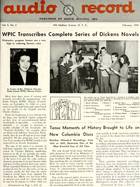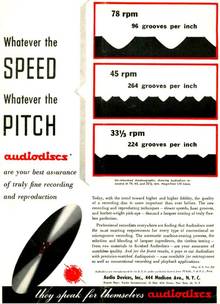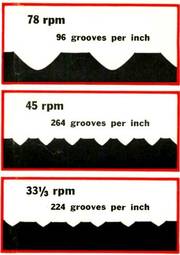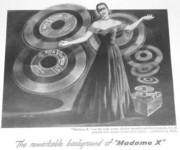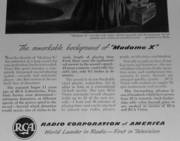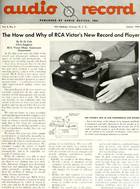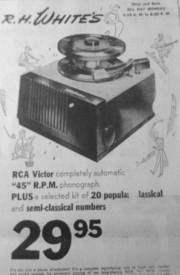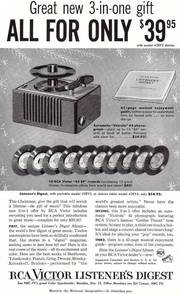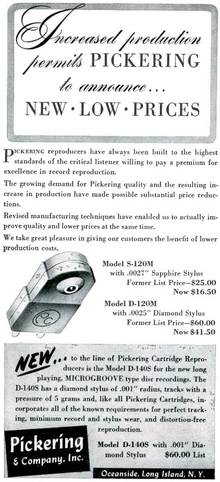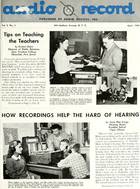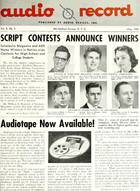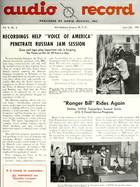Die Zeitschrift "audio-record" - Was ist (war) das Besondere ?
Diese Firmen-Zeitschrift war Jahrzehnte verschollen. Doch da stand eine Menge über den nationalen amerikanischen unabänderlichen Weg zum ungeliebten (und teilweise diffamierten) deutschen Magnetophon-Tonband drinnen. Mit diesen Informationen kann jetzt eine Menge an Schallplatten-Historie und ganz früher Magnetband-Historie "gerade gerückt" werden.
.
In der Januar Ausgabe 1949 wurde vermutlich die neue kleinere Microgroove Rille der 33er Vinyl LP im Detail vorgestellt ......
Leider fehlt in dem Sammelband 1945-1952 (es ist eine große PDF-Datei) auch diese Ausgabe, denn eigentlich wurde die 33er Vinyl LP bereits Mitte 1948 von der Plattenfirma Columbia Records in den Markt publiziert bzw. lanciert.
.
audio record - 1949 - 01 (Vol.5 - No.1 - January fehlt)
.
audio record - 1949 - 02 (Vol.5 - No.2 - Feb.)
Es gibt neue Columbia Platten mit den wichtigen historischen Events von 1933 bis 1945.
Vermutlich in Ausgabe 1/1949 wurde die neue Micro-Groove vorgestellt, doch diese Ausgabe fehlt uns. Jetzt folgt der ausführliche Part 2 mit dem Titel : "Microgroove in your studio- Equipment - Requirements". Eine erste Frequenzkurve ist abgebildet.
.
Ein weiterer Artikel lautet : "RCA Victor's New 45 RPM Record" und danach : "Mehr Fragen als Antworten".
.
Tense Moments of History Brought to Life on New Columbia Discs
Priceless Historical Recordings, from 1933 to 1945, Dramatize One of the Most Eventful Eras of All Time
The past decade holds many unforgettable memories for all of us. Memories of world shaking events and screaming frontpage headlines. But, perhaps more clearly than anything else, we remember the radio. How we used to listen tensely, eagerly, anxiously to the news broadcasts - to the voices of commentators, correspondents, and men who were making history both at home and abroad.
Few of the general public, however, realized that at the same time these memorable voices were coming to us over the air, the recording turntables back at the station were quietly at work, engraving a permanent record of the drama that unfolded day by day.
The vast library of historical reference recordings and transcriptions filed away in the archives of the country's leading broadcast stations can tell one of the most dramatic stories of all time. They can bring to vivid life events long gone by - they can speak to us with voices of those no longer here.
.
Unbezahlbare historische Aufnahmen - sie waren nie public
These priceless historical recordings, however, have not previously been available to the public. But Columbia's recently released album entitled "I Can Hear It Now" brings a collection of dramatic historical selections to all who want to hear and remember. It is available in an album of five 12-inch discs and also on a single LP Microgroove record. This collection was prepared by Edward R. Murrow, radio news reporter, and Fred W. Friendly, radio producer and script writer. The compilation of this material was, in itself, a monumental task. Over a period of more than 2 years Mr. Murrow and Mr. Friendly played back a total of more than 500 hours of old broadcasts.
.
Und jetzt etwas ganz Besonderes : das Magnetband ist da.
Over 100 hours of this material were recorded from the lacquer to magnetic tape.
.
- Anmerkung : Das war ganz sicher nicht im Sinne des "Audio Device" Firmenchefs, der ja zwei Ausgaben vorher der lacquer disc noch die ewige weltweite Einmaligkeit bescheinigt hatte. Ob er den Redakteur danach gefeuert hatte ? Wir wissen es nicht. Wir wissen nur, daß das Magnetband völlig einmalige Vorteile gegenüber dem sogenannten Re-recording (nochmal aufnehmen - wir nennen das "Schneiden" oder "Umspielen") von vorhandenen Platten auf neue Platten hatte und "sie" haben es alle gemerkt, also diejenigen, die solche Jobs durchführen wollten bzw. mußten.
.
This (das Magnetband) provided a flexible medium from which the final selections were made, and re-recorded on disc form, with narration by Mr. Murrow. His commentary unifies and explains the historical selections, leading the listener effortlessly through the highlights of a 13 year period, from 1933 to 1945. The events recorded are not necessarily included in their precise chronological order, but rather are arranged to give the maximum dramatic effect to the entire presentation.
The first famous voice to be heard is that of Will Rogers, from a recording made in 1932. This is followed by the very familiar voice of Franklin D. Roosevelt, in his message of encouragement to the nation on March 4, 1933. His voice is heard again and again - the last time in his report to Congress on the Yalta meeting. Then comes Huey Long - the Duke of Windsor in his abdication address - Fiorello H. La Guardia - Alf Landon - and John L. Lewis. You hear a dramatic on-the-spot account of the Hindenburg disaster - the voice of Neville Chamberlain telling a falsely relieved world that, after the acquisition of Sudetenland, Hitler will make no further territorial claims . . . and then the fanatical voice of Hitler himself, in an address to Edward Benes.
seltene historische Aufnahmen vom Verlauf des 2. Weltkriegs
Other voices tell of the invasion of Poland - Italy's entry into the war - the fall of France. And later the tense moments of December 7, 1941 are brought startlingly to life, with John Daly interrupting a regular musical broadcast, informing a shocked and horrified narion of the Pearl Harbor attack. Then there is the U. S. declaration of war - the tremendous impact of D-Day - the Nazi invasion of Russia - and finally Hiroshima and the Japanese Surrender.
This is but a suggestion of the full historic contents of "I Can Hear It Now." Not only does it bring back memories more dramatically than could possibly be done by the written word - it points out the as yet untouched possibilities that actual historical recordings can play in the educational field. It is to be hoped that this Columbia Album is but the first of many similar record collections which will be ofi^ered to the public. For there is certainly a wealth of this interesting and instructive material available - both in the extensive files of the recording and broadcast companies, and in the hundreds of thousands of disc recordings made by government agencies such as the OWI and the Library of Congress.
MICROGROOVE IN YOUR STUDIO (Teil 2)
Part 2, Equipment Requirements by C. J. LeBel, Vice President, AUDIO DEVICES, Inc.
.
- Anmerkung : Leider fehlt uns diese "audiorecord" Januar 1949 Ausgabe. Das ist sehr schade, weil dort erstmalig das neue "microgroove recording" insgesamt vorgestellt wurde.
.
In our last issue (wie gesagt, die fehlt uns) we discussed the three steps in the transition from standard to microgroove recording, steps which may he taken by any recording organization.
In taking these steps it is necessary to make certain changes in equipment. The most important is provision for cutting at micro pitch - in the range of 224 to 260 lines per inch. Probably 224 to 240 lines is the most desirable range for most applications.
Some equipment already made has provision for this without change - that originally designed to provide continuous variation of feed pitch. In other apparatus some change is necessary. An overhead feed mechanism relies on a change of leadscrew for change of pitch. To make the shift, then, it is only necessary to purchase and insert a new leadscrew.
The swinging arm type of feed mechanism requires a little more effort. The feed action is produced by the operation of a worm and gear sector. The manufacturer of the machine can remove the worm and substitute another of different characteristics. He also has a removable worm arrangement, so that the machine can be changed back and forth between micro- and standard- groove. The change is not as easy as desired, for the chassis has to be lifted up in the case. However, such a change is not one to be made often, and the arrangement is satisfactory.
Some recording machines have too much vertical vibration to be used for microgroove, unless an advance ball is used. The machine manufacturer can advise on this point, and can supply an advance ball rig if necessary. Inexpensive semi-professional swinging arm feed type machines are most likely to need this attachment.
.
The electrical characteristics
The electrical characteristics are even simpler to achieve. When recording regular 16" transcriptions with standard groove spacing and microgroove radius, we would use normal transcription recording characteristics. This would be either the NAB standard 16db boost at 10,000 cycles) or the 10db boost which many studios have found to be their usable limit.
Columbia microgroove characteristic is the same as NAB, except that the response is slightly higher below 100 cycles. A simple equalizer will take care of this. For a great deal of work the difference is negligible, and standard transcription equalization can be used.
We have carefully refrained from commenting on the 33 1/3 vs. 45 rpm situation. At the start, the average studio will have only 33 1/3 rpm equipment, so there will be no question of choice. Only time and experiment will indicate whether 45 rpm will become a serious factor in the average studio.
It is evident that the transition to microgroove is an easy one from the equipment point of view. The subject will be discussed further in our next issue.
Part 3 will be : COMPARISON OF COLUMBIA LP MICROGROOVE AND NAB RECORDING CHARACTERISTICS
.
Und jetzt eine Story : Wendt's "Wax Works"
The Story of a Record-Making Musical Family
Bill Wendt, a 16 year old student at Thomas Jefferson High School, Richmond, Virginia, was one of the three talented students selected to appear on the Philharmonic Symphony's CBS program "Week End With Music," on October 17, 1948. That's how we first heard about Bill, who is not only an accomplished musician on the violin, piano, cello, string bass, and bells, but is also an up-and-coming recordist. As this is a rather unusual combination of talents, we felt that our readers would be interested in hearing about his recording activities.
.
So here's the story
So here's the story in his own words, as quoted from his letter to the editor of Audio Record :
"I have been doing my own recording work for approximately ten months, having been introduced into this field by my oldest brother, Frank, who first became interested in audio work about seven years ago. When he entered the service he passed on to me his information on recording. While he was away my interest in this field grew considerably with the cutting of numerous discs, but as yet I have not had time to become well acquainted with the more technical side.
All of the equipment was built by my brother with the exception of the recorder itself which is a "Rec-O-Kut" 16 inch recording table with the same make overhead feed; a combination that has served quite well considering the relatively low price. The cutter is a "Presto 1-D", which is driven by an amplifier using a pair of 6B4's and a UTC out-put transformer #LS-55. Fifteen watts, however, is not sufficient for recording piano with its ever-present peaks, and I am now helping Frank to build a 60 watt amp. You see, this recording hobby is a sort of mutual affair between us; I learn from my brother by helping him.
The mixer unit shown employs three channels with 200 ohm T pads as mixers and has D.C. applied to the filaments. The W.E.633A dynamic mike, G.E. variable reluctance cartridge, and a Jensen JAP-60 woofer-tweeter combination all add up to fine recording and listening. Other equipment includes several more amps of ten and forty watts, an audio oscillator, and a 5" scope, all built by my brother.
Our recordings from the radio are composed mostly of programs presented by the New York Philharmonic, N.B.C., Philadelphia and Detroit Symphonies. I prefer to record works that have never been issued by record companies; consequently, most of our recordings are unavailable elsewhere.
.
My kind of music :
I might add that our most prized recording is the first made on the present equipment. It is the "Symphony in A" by John Powell played by the Detroit Symphony. Mr. Powell has used this recording to make corrections on the copy of his score as well as for criticism. We were hoping to have the Philadelphia perform this work sometime this year, but evidently it could not be worked into their program.
I have made recordings of my own voice for speech practice, but Frank has made most of the recordings of our family. We are all musical, all six of us, which offers a lot of material for recording. Several months ago my other brother, Don, startled his friends by recording himself playing the flute, violin, clarinet, oboe, bassoon, and bass all at the same time. It sounded like a full orchestra.
Our record library consists of about 100 hours of classical music at 33 1/3 rpm on 16" discs, twenty or thirty albums of commercial records, and ten Columbia LP records which are very fine. My one big trouble is finding time to listen.
As yet I am not certain, but I will probably major in music on the string bass and try for a symphony position or go into radio production. Frank has definitely decided to make music and the audio field of electronics his profession, and I might add that he is now engaged in recording Virginia's foremost pianist and composer, John Powell, at the piano. Some ef these recordings have already been pressed and released to the public. I am proud to say, that they have been rated by critics as equal to any commercial piano recording released by the large companies.
Well - that just about covers the high spots. I hope it will be of interest to you and your readers.
P.S. I have yet to find a better disc than the red label Audiodisc, and I'm very glad that you have licked the humidity problem. That gave me problems, also."
Report on "Madame X," (February, 1949)
RCA Victor's New 45 RPM Record
We have received a number of requests for information on the new RCA Victor 45 rpm record, "Madame X." No technical information has yet been released, but we have collected the available data on the subject. Here it is in brief.
X is a thin 7" pressing of pure vinyl. The center hole is large - about 1 1/2 inches in diameter. Maximum playing time is 5 1/2 minutes. Fine grooves are employed, and the playback stylus radius is 1 mil. Price is slightly under that of an ordinary shellac pressing of the same playing time. So far as we can tell, the recording characteristic is the same as that used on standard Victor records.
The large center hole permits the use of a special record changer of very interesting properties. The record stack is carried on the large size center spindle; there are no outside supports. As a result the changer is extremely compact and extremely rapid. Several observers have timed the change cycle at II/2 seconds. To simplify the mechanism, all discs are of the same diameter, regardless of playing time. Record changer manufacturers are getting ready for production, and it is rumored that the simplicity of the mechanism will permit a net price of $5.
The point which has aroused the widest controversy is the speed: 45 rpm. It is rumored that 33 1/3rpm was tried and discarded because of difficulty in securing reliable processing in mass production, when using the slower speed. A moment's consideration will show that for a given diameter, 45rpm will give 35% higher linear groove velocity than will 33rpm. It would be possible to get the same linear groove velocity at 33rpm by increasing the outside diameter to 9 1/2 inches, which would increase the vinyl cost 82% over the 7 inch size. In short, the higher speed is a means of exchanging playing time for wider frequency range and reduced tracking distortion (with a fixed outer diameter).
Our readers will be interested to know that RCA Victors engineers have promised us an article on "Madame X" for our March issue.
Two More Questions and Answers on LP Records
In the November issue of the "Audio Record" we asked if there was anything else our readers would like to know about LP microgroove records. Here are two of the questions received which we believe are of general interest and are not covered in the questions and answers previously given.
.
- 1. Question: Is more volume required in playing the new LP microgroove records on duo-speed record players because of the decrease of amplitude in the grooves?
- Answer: One needs about 3db more volume.
- 2. Question: In what ratio is sound to surface noise compared to both LP and standard pressings?
- Answer: LP is about 15 db better than standard pressings. In other words, the sound to surface noise ratio being about 40db in standard pressings is 55db for LP.
.
audio record - 1949 - 03 (Vol.5 - No.3 - March)
Der neue RCA Victor 45er Plattenspieler, (bei uns wurden diese Platten Singles genannt) wird vorgestellt und ausführlich beschrieben. Man beachte das große Mittelloch, das RCA damals noch für die 10fach Wechselautomatik brauchte.
In Amerika begann das große Wettrennen, wer diesesmal den neuen weltweiten Standard mit der Micro-Groove zu setzen imstande war, Capitol oder RCA Victor .
.
Jetzt folgt der ausführliche Part 3 mit dem Titel : "Microgroove in your studio - The Stylus".
.
Die neue 45er Single mit 17cm wird hier vorgestellt
.
The How and Why of RCA Victor's New Record and Player
By D. D. Cole - Chief Engineer - RCA Victor Home Instrument Department
In the fifty years sinee the birth of the record and phonograph industry, many types of records and phonographs - of various sizes, revolving speeds, and design - have been developed. But for the first time in the history of recorded music, there has now been evolved a record with a matching player, a player with a matching record. RCA Victor's new music reproducing system for the home consists of the first record and player designed as complementary units - a combination which provides unprecedented quality, service and efficiency.
Our introduction of the new system was carefully considered. As the only manufacturer of both phonographs and records, we had a great deal at stake. We based our decision on our confidence that this system is the best we have ever put on the market, and our sincere belief that it is the best that anyone has ever put on the market.
We east our future on a new recording and reproducing system that requires a new player and a different type record, but provides in return a record-changing mechanism that is free from the conventional troubles, and a record that provides a new high in reproductive quality, low cost, and a convenient size.
.
Es begann vor 50 Jahren
We began, fifty years ago, with a simple record player - a single-play, manually operated player. Through the years, we have called upon the player to perform more and more difficult operations and services. The consumer wanted the player to handle large numbers of records, to change them automatically, and to be adjustable for records of various sizes.
While the industry was able to meet these requirements, it found that in meeting them it was running into new problems. Automatic changers were developed,
improved, and simplified, but many difficulties persisted - perhaps chief among them the problem of damage to records during changer operations.
More than 10 years ago, RCA Victor began in its laboratories a program of study and development by which it hoped to solve, once and for all, the problems which had piled up on the industry since the beginning of recorded music. We were willing to stake our future on a system that would solve the problems still encountered with all conventional record changers and provide optimum reproduction quality, economy, and convenience.
Der Plan von RCA Victor
Initially, we sought to do these things:
- 1. Provide a means of automatic record changing without damage to records.
- 2. Eliminate the need for adjusting a record changer for records of different sizes.
- 3. Reduce the time required for record changing and make the operation silent.
- 4. Eliminate from the overall player as many as possible of the conventional moving parts.
- 5. Reduce the overall size of the player and record, which we considered larger than necessary, and which required large phonograph cabinets and excessive record storage space.
.
The way of automatic record changing
We tackled the record changing problems. In most conventional systems, the drop mechanism operates from one or two posts located along the outer rim of the turntable. This calls for a large changer, since the post or posts, to handle 12-inch records, must be about 7 inches from the center of the turntable. It also calls for indexing mechanism so that the post can be adjusted to handle 10-inch, as well as 12 -inch records. Changer blades in most conventional systems also present record chipping problems, since the design requires them to force themselves between the stacked records.
The solution soon became clear to us. We could not solve the overall changer and record problems by designing a new record to fit conventional changers, or by designing a new changer to handle conventional records. We had to design both, a new record and a new changer, complementary units, that together would eliminate the basic problems of record changing.
It was found that problems of size and indexing could be solved with a changer mechanism operated from the center of the record. By eliminating outside record posts, it was possible to reduce the dimensions of the player's motorboard from 15 to 11 inches to 10 by 7 inches.
Accordingly, we developed a changer with a drop mechanism which could be housed in a 1 1/2" center spindle.
Eine ganz dünne mechanisch stabile Platte
By designing our record with a raised shoulder between the playing area and the rim of the center hole, we were able to produce a wafer-thin disc that had the necessary rigidity, and provided air spaces between the center rims of the stacked records for the operation of the changer blades. The shoulder also provided air cushions between the playing surfaces, eliminating scratching of recorded grooves.
The blades of the new changer never touch the recorded grooves of the record. On the center spindle are two supports or shelves, which form the support for the record stack. When records are changed, the two shelves recede into the spindle, and simultaneously two changer blades move out through slots in the spindle and into tiie air space to form a shelf for all the records stacked above the bottom record. As the bottom record drops gently to playing position, the shelves emerge again to take over the holding job from the blades, which then disappear into the spindle.
Since the shelves are latch-type projections, records cannot be forced down over them, but records being removed from the turntable automatically depress the shelves as they are brought up over the spindle.
Der schnellste Wechsler "in the industry"
Through novel design, we developed not only a simple record-changing mechanism but the fastest one in the industry. On the underside of the turntable we designed a cam track that swings the arm up and out from the records, drops a new record, and brings the arm back to playing position in about two seconds.
The large center spindle and the design of the trouble-free drop mechanism called for the designing of a new type of record to fit our new player.
With our changer and player plans formulated, we turned our attention to the record. Our plans called for a record as unique in its characteristics as the player.
Again, let us look to the past. Here, the record, too, has undergone a steady evolution of progress and advancement. As we advanced from acoustic to electric recording, and from acoustic to electric pickups, recorded music became finer and truer. But, as we cut down some covering noise, such as motor rumble and needle chatter, record surface noise became audible.
Conventional records also posed other problems which we insisted on solving.
.
Unsere neuen Grundsätze für diese Entwicklung
Here are the objectives we sought:
1 . Elimination of discernible surface noise and distortion, even at wider frequency ranges which may be used as better and better instruments are developed.
2. Reduction of the size and weight of records, making for lower cost, easier handling, more convenient storage, and faster and quieter action of the changer mechanism.
Distortion is caused by the inability of the stylus to track properly in the record groove. On standard records, this becomes more apparent as the stylus moves from the outside groove of the record toward the center.
Whether we use the standard 78 rpm, the conventional transcription speed of 33-1/3 rpm, or the new 45 rpm, the stylus will cover a greater distance in any given interval in the outside groove, and less and less as it moves toward center.
Although the turntable revolves at a constant rpm rate, the stylus will track the groove at an increasingly slower linear speed as it approaches center. Beyond a certain point, the modulations are crowded so close together that the stylus has difficulty in tracking, and distortion results.
The area up to that point in the record is called "the quality zone", where there is no discernible distortion. Beyond that critical point on any record, of any size or revolving speed, distortion is set up and becomes more and more apparent, the closer the stylus moves toward center. We determined, then, that our new records would not be recorded past the critical point - the music would be recorded entirely within the quality zone of the record.
- Anmerkung : Sie wußten es bereits 1949, das mit der "Qualitiy Zone". Über einen "certain" point hinaus, also über einen bestimmten Punkt hinaus, steigen die Verzerrungen mehr und mehr an, unabhängig von dem Durchmesser und der Drehgeschwindigkeit.
.
Das Ziel bzw. der Wunsch : Eine Platte für jeden Bedarf
While we desire to reduce the size of the record, we also wanted to maintain the playing time associated with standard 12-inch discs - up to five and one-third minutes - and we wanted to put the entire five and one-third minutes within the quality zone of the record. We also wanted to eliminate the need for records of more than one size. We sought a one-size record that could handle all classifications of music - popular, classical, hillbilly, and rhythm.
Having established the size of our center spindle, we knew, we required a record with a center hole 1 1/2 inches in diameter. We had to allow space for the raised shoulder and the label, and additional space for the lead-out groove, which carries the tone arm to the tripping point for operation of the changer mechanism.
The new step was to determine the minimum overall size required to offer five and one-third minutes of "quality-zone" music.
By scientific and listening test, we established the critical point beyond which we could not record without discernible distortion. With that point established, we began to buildout - to provide the smallest record providing the desired playing time. The tests indicated that our new record, to meet all of our goals, should be 6 7/8 inches in diameter, and operate at 45 rpm.
.
6 7/8" Durchmesser und 45 rpm - das wars
We made our records of non-breakable vinyl plastic for minimum surface noise, and developed a tone arm that exerts only five grams of pressure on the record. The stylus has a .001-inch tip radius. The combination of fine-point stylus and light pressure makes for less record wear and a more sensitive pickup. RCA Victor's famous "Silent Sapphire permanent-point" pick-up is employed in the new tone arm, though it is only approximately one-third the size of the standard Silent Sapphire cartridge.
We have been asked by those who are not familiar with record engineering why we did not design our new system for operation at the familiar home phonograph speed of 78rpm or the conventional transcription speed of 33-1/3rpm. The simple answer is that at either speed we would have been required to make a larger record - thicker and without the raised shoulder feature, at 78, or larger in diameter, if we were to maintain the same quality level, at 33-1/3.
Nothing would be gained by such a compromise, since use of the unique and vastly improved record changer would require a record of complementary design, regardless of operating speed. Since the advantages of the new system could only be made available to the consumer through the combination of a new record and a new player, there was no advantage in clinging to an old standard. This left us free to make the system in every respect the best ever developed at low cost.
Ein fließender Übergang von 78ern auf 45er ist versprochen
As previously stated, RCA Victor will continue to serve the standard market by making all selections recorded for the 45 rpm system also available on 78 rpm records. To insure a smooth transition, we will also make Victrola radio- phonographs with playing facilities for both types of records, as well as instruments incorporating only the new system.
Summing up, then, we have in our new disc a record that provides up to five minutes and 20 seconds of music that is free from discernible distortion and surfice noise, with every note recorded in the es tablishcd quality zone of the record.
Having a standard size disc, that will take both the popular and classical categories of music, we have eliminated the confusion of indexing changers and have gone a long way toward solving the record storage problem in the home, the warehouse, and the dealer's shop. The small record and changer will also permit an overall reduction in the size of console instruments and give the stylist unprecedented latitude and flexibility in cabinet design.
The changer itself has solved many of the problems encountered with conventional changers. From the consumer standpoint, this changer assures a gentle handling of precious records, and the blades cannot scratch, chip, or break the records. It also provides silent operation and the fastest changing action of any mechanism yet devised.
Our complete faith in the quality, service and merit of this new system is implied in the simple fact that we are planning around it our future in the record and phonograph business, in which we have the largest stake (Pfahl / Position) of any organization in the industry.
.
Questions and Answers on the New RCA Victor Record Playing System - (Prepared for Audio Record by RCA Victor)
Question : Why was the new RCA Victor Record Playing System developed?
Answer : With the advent of the automatic changer, mechanical difficulties were encountered because of the lack of standardization of records. The cost of repairing changer units, plus the inconvenience to the consumer, prompted RCA Victor to commission its engineers to develop a new system based on the following objectives:
.
- 1. To develop a trouble-free automatic mechanism for changing records.
- 2. To design a record with the following features:
- a. Distortion-free reproduction
- b. Minimum surface noise
- c. Maximum quality and tone
- d. Smallest practical size
- 3. To disregard all limitations or restrictions formerly placed on the designer of both players and records.
.
- Question : Why 43 Revolutions per minute?
- Answer : For the size record selected, and the extremely high quality standards adopted, it was determined mathematically that 45rpm was the slowest speed that would accomplish the desired results.
- Question : How does it work?
- Answer : Contrary to present methods, the new system is based on the principle of a 7 inch record with the size of the grooves reduced, revolving at 45 rpm on a specially designed player, and reproduced by a lightweight jewel-point pickup. All of these factors contribute to greatly improved quality of reproduction.
- Question : Why a 7-inch record?
- Answer : The 7-inch record has many advantages: easy handling . . . small, efficient, attractive ... no storage problems . . . sturdier product with less wear . . . same amount of music as recorded on a 10 or 12-inch record ... the entire recorded surface limited to the quality zone.
- Question : Is this a long-play record?
- Answer : No, the new record has a playing time of up to five minutes twenty seconds within its "Quality Zone". . . undistorted reproduction . . . approximately the same playing time as standard records. However, with the development of the new RCA Victor rapid changer, the lapse between records has been greatly reduced.
.
.
- Question : How does the new Rapid Record Changer work?
- Answer : The changer operates entirely from the center hole of the record. The spindle of this changer, which is 1 1/2 inches in diameter, houses the trigger action mechanism, which drops the records swiftly and silently to the turntable below. The entire operation takes only two seconds. This is the world's fastest record changer - and also the simplest mechanically.
- Question : Can I use this system with my present radio?
- Answer : Yes, you may purchase an attachment which will play through your present radio or phonograph, regardless of make.
- Question : What types of instrument will be available with this new system?
- Answer : The new RCA Victor system will be available not only in the attachment which you can use with your present radio, but also in complete table model phonographs, table model radio-phonographs, console radio-phonographs, and console combinations with television, radio and phonograph. These instruments all have the famous "Golden Throat" tone system.
- Question : How many records will the Changer hold at one time?
- Answer : The changer accommodates 10 records, which change automatically without attention, providing up to 30 minutes of listening pleasure at one sitting.
- Question : What type of Needle is used with this new player?
- Answer : There is no needle. This system uses an improved "silent sapphire" permanent point pickup.
- Question : How heavy is the tone Arm?
- Answer : The tone arm exerts a pressure of only five grams on the record. Obviously this reduces record wear.
- Question : Is it expensive?
- Answer : No. the new RCA Victor system was developed with low cost in mind - both for the record playing equipment and the records themselves. As a matter of fact, the savings in record purchases will pay for the player in an amazingly short period of time.
.
.
- Question : How much cheaper are the records?
- Answer : Up to 33% in albums, and 24% in single records, depending on the type of entertainment you want.
- Question : Will the fine grooves present a problem ?
- Answer : No. The records are so designed, with a center shoulder providing air space between each record, that the playing surfaces do not touch while the records are on the changer or in storage. Further, the large center hole and the size of the record itself permits easy and careful handling; fingers never need touch the playing surface of the record.
- Question : Are all the records 7-inch?
- Answer : Yes. all seven inch, a complete standardization of records, but there is a color code for each type of entertainment.
- Question : What do you mean by a color code?
- Answer : Each musical category will be recorded on a different color record. For example: Red Seal music - red record - Popular music - black record - Country and Western music - green record - Children's Entertainment - yellow record - Blues and Rhythm music - cerise record - International music - sky blue record - Popular classics - midnight blue record.
- Question : How many selections are recorded on one side of the new records?
- Answer : The records are recorded just as you are accustomed to hearing them on 78rpm records, side for side.
- Question : Will only RCA Victor make this new type record?
- Answer : Other manufacturers, in addition to RCA Victor are planning to make this new type record. Others are planning to make the new player.
- Question : Are you still going to make the conventional record?
- Answer : Yes, all selections recorded for the 45 rpm system will also be available on 78 rpm records.
- Question : How long did it take RCA Victor to develop this new system?
- Answer : Research and experimentation began in 1939. By 1942 the first model was perfected. Then followed years of testing and refinement from which finally emerged the new RCA Victor record playing system.
.
MICROGROOVE IN YOUR STUDIO - PART III - THE STYLUS
by C. J. LeBel, Vice President, - AUDIO DEVICES, Inc.
We are continuing our discussion of the problems of microgroove recording with a study of the most difficult problem, that of the cutting stylus. It will be recalled that a recording stylus has a burnishing facet which "breaks" the cutting edge. This polishes the groove walls, removing some of the scratches of cutting, and making a quieter groove. The effect is just like that of the dulled edge (on a lathe tool) used to produce a shiny cut in turning metal.
In 1942 (siehe Fussnote) the writer published a study of the effect of the length of this burnishing facet on the high frequency response. The longer the facet, in terms of groove wavelength, the more the attenuation. A facet length of less than 0,15 wavelength produces no attenuation. While the original study involved transcription size grooves, undoubtedly the results are not far off when applied to microgroove, as we will do.
The data presented covers only the diameter effect produced by the facet - that is, the recording loss only. Reproduction by a stylus of finite size produces a reproduction diameter effect, which adds to the recording loss. Reproduction or tracing loss is fixed by the groove velocity and stylus size, and we can do little about it, so that recording loss is all that we can minimize.
The data is presented in terms of the relative loss, that is, the difference in diameter loss between 1,000 cycles and the frequency under discussion. There is a small loss at 1,000 cycles, too, but this can be compensated for so easily that it is not worth considering.
.
In modern transcription work, cutting at 136 pitch for a maximum of 15 minutes, we come in to a minimum diameter of 8 inches.
We then observe the following:
Tabelle
For ordinary transcription work, if we are willing to accept a loss of 3db at 8 kc or 4 1/2 db at 10 kc, at 8 inch diameter, then a facet length of 0,5 mil is the largest we can use. For those who wish to make transcriptions with a fine-bottom groove, for reproduction with either standard or micro stylus, we have available a stylus with small tip radius and restricted facet length, our type #14SM (standard microgroove). This dural shank recording sapphire sells at the same price as our present #14 and can be resharpened at the same price.
*) Reference : Properties of the Dulled Lacquer Cutting Stylus, C. J. LeBel, Jour. Acoust. Soc. Amer. Vol. 13, No. 3. pp 265-273. January 1942.
audio record - 1949 - 04 (Vol.5 - No.4 - April)
Anscheinend sehr wichtig : "Teaching the teachers". aber nicht gut zu verstehen
Wesentlich interessanter ist der Artikel "Recording Tape to Disc".
.
RECORDING TAPE TO DISC (April, 1949)
by C. J. LeBel, Vice President, Audio Devices, Inc.
A new field for the recordist has broadened astonishingly (überraschend / verblüffend) in the last year. This is the practice of making recordings in the field on tape, then re-recording the material onto discs in the studio.
Using the light weight and improved quality of the latest tape recorders, and the erasable feature of tape, a considerable number of studios have made a very successful career out of recording professional and amateur orchestras, church choirs, and the like. Generally, a single recording will lead to the sale of twenty-five or fifty discs.
The erasable feature of tape is particularly helpful with groups which are not used to recording procedure. Errors can be edited out with a pair of scissors, or the tape simply re-recorded.
Fidelity Requirements
In re-recording the high frequency attention and distortion effects are additive, so that both tape and disc recorders must be better in quality than if either were used alone.
Home type machines appear very attractive for this work due to their light weight, but caution should be exercised. The older machines had excessive distortion and limited range. Some of the newer machines have excellent distortion characteristics, but the frequency response is uniform only to 5.000 cycles. Rebuilding such a machine, modifying the equalization to extend the frequency range, would appear attractive. Extending the frequency range probably will call for raising the bias frequency. This should be done carefully, to maintain the same bias current as nearly as possible.
.
- Anmerkung : Ich vermute, der Mr. Lebel konnte sich damals nicht vorstellen, wie schnell die Qualität auch der Homerecorder weiterentwickelt wurde. Alleine hiervon hätten die Väter der CC-Kassette von Philips (1963) bereits lernen können, wie man sich irren kann.
Die Studiomaschinen von Ampex konnten bereits 12.000 Hz sauber aufzeichnnen. Die beiden AEG K4 von Jack Mullin konnten damals bereits fast 15.000 Hz sauber und verzerrungsfrei auf das deutsche 6,5 mm breite Magnetband aufzeichnen, so hatten es die Ingenieure bei Bing Crosby ausprobiert und dementsprechend den Bauauftrag für die ersten 20 amerikanischen Geräte an Ampex vergeben.
.
System Adjustment
If the tape recorder is fitted with tone controls, these should be adjusted for the most uniform overall response. In most cases this means turning the high frequency control up all the way. The disc system should then be adjusted for most uniform response, plus preemphasis if used.
It occasionally may be desirable to vary the overall response, but this should be done with great caution. It is better to do such modification in recording, rather than in the original tape. A serious mistake, then, cannot ruin the original recording. Modification of response characteristics should be done very rarely, only if absolutely necessary.
Tape Recorder Improvements
While we believe it desirable to spend at least $400 for the tape recorder, there are many studios with limited budgets which will want to buy a lower priced machine and rebuild it themselves.
First, a 500 ohm output impedance is highly desirable. A simple change in out put transformer will take care of this.
Secondly, fit a volume indicator motor if the recorder is normally supplied only with a newon lamp for level indication. In this connection, remember that VU meters are available in small size on special order, and that they are much better than the old style general-purpose volume indicator which is more readily available in the smaller case.
Next: reduce the amplifier distortion by change of tubes or addition of negative feedback if necessary. Certain older home recorders need such improvement if they are to be used at all.
Finally, be sure to use a microphone of professional quality. The microphone generally supplied with a home recorder has limited frequency range and a strong peak. This change may require the addition of a pre-amplifier stage if the professional microphone has as low sensitivity as many do.
Tape Recording Level
Commercial tape recorders do not have as great signal to noise ratio as their laboratory prototypes, and lower cost home machines are, of course, poorer than professional units. Some home machines can
be improved by rewiring, proper shielding, and correct position of ground connections, and time so spent is well invested.
Nevertheless, there is a great tendency to record at too high a level for the sake of achieving as high signal to noise as possible. The cure is worse than the disease. Tape recorded at excessive level seems to have a veil over the higher frequencies, and the effect is most objectionable.
A home type tape recorder will have a usable-signal to noise ratio of the order of 35db, and a professional machine but little over 50db if at all. Use the range available and be content. Do not try to stretch it at the expense of poor sound. The fault is no more excusable because it is so common. Pay no attention to the siren call of advertising literature with its ever louder claim of lower and lower noise levels.
We have heard demonstrations in which the tape level was so high that heavy volume compression was taking place. Nothing will so quickly destroy the character of a recording as to have 10db of the peaks removed by the compression action of overloaded tape. Summarizing, set your recording level by ear and meter tests, and not by catalog claims.
1949 I.R.E. SHOW TOPS 'EM ALL !
The 1949 National Convention and Show of the Institute of Radio Engineers (I.R.E.), held March 7-10 1949 in New York's Grand Central Palace and Hotel Commodore, chalked up a record-breaking attendance of over 16,000 persons. Prominent among the show's 225 exhibits, was The Audio Devices booth, shown above. Featured in the center panel are three gold-sputtered Master Audiodiscs of recordings made at 78 rpm (96 grooves per inch), 45 rpm (264 grooves per inch) and 33-1/3 rpm (224 grooves per inch), each accompanied by an actual shadowgraph magnifying a section of the recorded surface 250 times. Also displayed were the various steps in the manufacture of Audiodiscs - and the complete line of Audiopoints. At this booth, more than 2500 copies of Audio Records were distributed, and approximately 800 new "subscribers" were signed up.
(This Audio Devices exhibit will also be on display at The Radio Parts Show in Chicago, May 17-20 1949, in Booth No. 24.)
Das neue AUDIO-TAPE ist endlich verfügbar.
.
audio record - 1949 - 05 (Vol.5 - No.5) (May)
Endlich - Audiotape ist verfügbar. Dafür gibt es einen großen langen Artikel gleich auf der ersten Seite. Sie haben gemerkt, daß ihnen sonst die Felle davon schwimmen. In dieser Publikation liest man es nicht, aber Ampex und 3M machten den gesamten Recorder Markt richtig nervös und die hatten eine sehr große Marketing Power. Denn Ampex war der erste Hersteller, der funktionierende Magnetofon-Geräte auf den Profi-Markt brachte.
Ein weiterer Artikel untermauert die Bemühungen der Entwickler, das sogenannte Research-Team, ein passables Magnetband aus dem Boden zu stampfen. Was der Colonell Richard Ranger und Major Herbert Orr mit seiner ORR Radio Firma da ehemals verkündete, er hätte nur 3 Wochen gebraucht, um das ORR Band (Irish) zu entwickeln, war natürlich völliger Humbug und Unsinn.
Diese Ausgabe 1949-05 hier ist vom Inhalt wirklich interessant.
.
Audiotape Now Available! (May 1949)
Audiotape has the unique distinction of being both the newest and the oldest magnetic recording tape in this country. For Audio Devices first started work on the development of Audiotape more than 2 1/2 years ago, at the time when samples of German tape recording equipment were first brought to this country for study and improvement. A plastic-base Audiotape which proved far superior to even the best German magnetic tape was produced well over two years ago. This tape would have been placed on the market immediately - except for one thing.
The product was good - but was it good enough to bear the "Audio-" trademark ? Audio devices' engineers, acting as their own severest critics, felt that there was still some room for improvement, and that Audiotape should not be released until they were thoroughly convinced that it had achieved the highest possible degree of perfection in every respect. So additional months of research and experimentation followed - to devise a still better, more uniform coating that would assure the finest, noise-free recording in a wide variety of machines, from low-cost amateur equipment to the most costly professional tape recorders. The problems involved in the perfection of Audiotape were more numerous and perplexing than the layman might expect with such a seemingly simple product. The article by Mr. LeBel, on pages 3 and 4 of this edition, however, will give some idea of the complexity and magnitude of the task.
To meet the most rigid requirements, and to assure premium performance in a variety of different recording and reproducing machines, it soon became evident that two different types of tape would be needed. For the frequency response, output level, and signal-to-noise ratio bear a definite relation both to the bias current used in a particular machine, and to the coercive force of the magnetic oxide coating of the tape. Many non-professional-type recorders on the market do not have a bias adjustment, and as the bias varies in different machines, a tape which would give optimum results with one machine would not give such good performance on a different, fixed-bias machine. Two different types of Audiotape were therefore developed - one with high-coercive, black oxide coating, and the other with coercive, red oxide coating.
.
Warum dauerte es 2 1/2 Jahre ?
Now - after 2 1/2 years of research, experimentation, and continual improvement - Audiotape is ready for the market. Audio Devices' engineers are confident, that it is the finest product "of its type" available - a product that will, in every way, live up to the exacting standards of quality and uniformity which have characterized Audiodiscs for more than a decade.
Paper-base Audiotape, in both the high-coercive and medium-coercive types, is now in quantity production - in standard 1250-foot, all-aluminum reels designed to fit all makes of machines. Audiotape will be available through Audio Devices' more than 300 distributors, conveniently located from coast to coast. Through these distributors, it will also be available to retail dealers, who can obtain large or small quantities for profitable re-sale to their own customers. Distributors and dealers will be provided with complete instructions on the use of Audiotape - including recommendations on the type of tape which will give best results with all of the various commercial tape recorders now available.
Audio Devices is now working on a new line of plastic-base Audiotape, which will offer certain advantages for professional use. The new tape will be announced shortly.
Audiotape is now a full-fledged, tried and proven product. Its development was a "natural" for Audio Devices - a company with more than 10 years of experience in the manufacture and distribution of recording discs. For the production of recording tape has much in common with the production of recording discs. Both involve a precision coating process - wherein the sound-sensitive material must be applied to a suitable base in a perfectly smooth and uniform coating. Also, both involve the same basic principles of audio engineering, and call for the same high standards of quality control and continual factory testing to assure the most perfect sound recording medium available.
Like Audiodiscs, Audiotape "speaks for itself."
.
- Anmerkung : Das war natürlich auch Marketing-Unsinn, denn die 3M Entwickler waren schon seit mindestens einem Jahr weg von der "paper-based" Trägerfolie hin zum Polyester-Material. Doch diese Entwicklung konnte keine Firma aus dem Ärmel schütteln.
.
RESEARCH PROBLEMS OF TAPE (MAY, 1949)
by C. J. LeBel, Vice President, Audio Devices, Inc.
This paper discusses the problems faced by our Research Department in the course of our tape development program. The solution in some cases is visible in the statement of the problem. In the remaining cases a discussion of the answers would take many pages, and we will have to defer studying them until subsequent issues of the Audio Record.
.
Our Original Tape
About two years ago we brought out our Type A tape. This consisted of an oxide with a coercive force of about 120 oersteds and a remanence of about 500 gausses, coated on vinyl copolymer with a vinly acetate binder. The design was based on German developments brought over by the U. S. Department of Commerce, and was designed for 30" per second speed. It was decidedly better than the German tape as regards frequency range and signal to noise ratio.
Marketing experience with this tape showed, that there were only about a half dozen professional machines (operating at 30 inches per second - 76cm/sec) in the whole country, but that there were many thousand amateur type machines, operating at 7 1/2 inches per second (19cm/sec), and requiring different bias characteristics. It was also evident that American recording machine design was developing differently than European, and hat entirely different tape characteristics would be necessary in the future.
.
The American Trend
From the experience of those users who were rebuilding home machines into semiprofessional jobs, it was possible to make an accurate estimate of the probable trend of design and operating practice.
It was evident that slower tape speed would be required. Thirty inches per second uses up tape very fast, and we guessed correctly that the professional standard would be in the fifteen to eighteen inch per second range. Late 1948 saw an NAB committee settle on fifteen inches.
At the same time we could see that wider frequency range would be necessary to 7500 cycles at 7 1/2 inches per second, and to 15000 cycles at 15 inches per second. A combination of the change in speed and the change in frequency range made the tape requirement three times as rigorous as European demands.
We could also see that equipment would have to run with less attention to head cleaning and the like.
The Basic Problems
With the basic assumptions made, it was possible to outline the basic problems for the laboratory. These could be allocated to the fields of: base, oxide, binder, dispersion and application.
Base
A plastic base would have to be found, with greater strength than the old vinyl, and which could be made in long lengths without splices. It would have to be perfectly smooth, and the thickness would have to be extremely uniform. It would have to be available in a thickness of 0.0015".
Paper Strength
We felt that if a very high grade paper base could be made, it would be possible to use paper instead of plastic for many more applications, at a substantial saving to the customer. So the development of a special paper was put on the agenda.
- Anmerkung : Das mit dem Papier wurde von allen Wettbewerbern einschließlich der IG-Farben/BASF schon sehr früh verworfen. Papier hatte keine innere Festigkeit und ist - egal wie dünn oder dick - sehr feuchtigekeitsempfindlich.
Tape paper must have extremely good smoothness, for this improves frequency response and reduces noise and distortion. This smoothness must be inherent - in the type of paper machine and processing. It is easy to make a rough, porous paper, then fill the pores with white pigment. This makes a poor base, however. The white pigment tends to rule off onto the capstan, producing slippage. It is possible to bond the pigment to the paper by adding a plastic resin to the paper pulp in the beater. This tends to stiffen the paper. If too much resin is used, the paper is stiffened so much that it fails to contact the heads properly and high frequency response is impaired.
It will also fail to wind compactly and the reel will be overfilled. If too little resin is used, the pigment will tend to rub off. The balance between chalking off and excessive stiffness is hard to maintain, and there really is no optimum compromise.
Knowing this, we decided to do it right - the hard wav - and work with a papermaker on an unfilled paper of great smoothness. This would insure best frequency response, lowest noise and lowest distortion. We were correct in judging that this would be a long job - it was. Part of the problem lay in getting adequate breaking strength - five pounds - while still retaining all other desirable characteristics Oxide.
As everyone knows, recording tape consists of a non-magnetic base coated with iron oxide. A wide variety of oxide chemical compositions and lattice structures are possible. Correspondingly, a wide range of magnetic properties are possible - a coercive force may be anywhere between say 90 and a maximum of 400 oersteds.
As was said before, wide frequency range was recognized as absolutely essential. It was also evident that low noise level would be required, to permit of as wide volume range as possible.
We guessed, correctly, that a wide variety of bias values would be in use, and that it would not be possible to get optimum performance at all conceivable biases with only one oxide. One oxide suited to high bias operation and another optimized for medium bias would be necessary. This raised another problem. Previous attempts at a high bias oxide had not been of professional grade due to excessive noise and modulation noise. The latter sounds like fuzziness to the ear and is highly objectionable. An improved high bias oxide was necessary.
One of the first handicaps in this work was the misleading nature of published studies on the relation of magnetic properties to recording characteristics. As applied to successive batches of a given oxide, coercive force and remanence have significance, but in comparing two entirely different materials the magnetic properties have but little more than a second order effect. Other factors may outweigh the magnetic properties in significance by twenty or thirty db. The need to actually coat and record on every experimental oxide was very time consuming, but in the end it proved worth while.
.
Binder (der Kleber)
The iron oxide (die Magnetschicht) is held on the base (auf der Trägerfolie) by a binder. This binder must withstand high temperature without softening, if the tape is to be used on some of the earliest home type machines used by broadcasters. It must not have a tendency to rule off and foul the heads. Finally, it must not have a high coefficient of friction, or its motion over the heads will not be smooth. This coefficient of friction must not increase with time or use.
The friction must be reduced by proper formulation and not by roughening the coating. The slightest shade of roughness will reduce friction (a curious phenomenon), but it will impair output and high frequency response also. Do not confuse smoothness (Weichheit/Biergsamkeit) with gloss (spiegelnde Oberfläche) - a tape which is full of little bumps (Flecken) (glatt/spiegelnd) may still be very glossy.
Dispersion (gleichmässige "Verbreitung")
An oxide works best if the individual particles are separated from one another by binder, just as the particles in a magnetic dust core are so separated. If the particles agglomerate together in clumps, the modulation noise increases. It was necessary to study the problem of dispersing oxide in binder very carefully. Unlike the paint and abrasive industries, the problem of dispersion was one of perfection, not of speed.
The importance of the dispersion problem may be realized when we find that a poor dispersion will have 10 db more modulation noise.
The viscosity of the coating solution must be carefully controlled, lest it fail to apply properly in the coating machine. Every coating machine, of any type, requires exact solution viscosity for the most perfect results.
Application (Anbringung der Beschichtung)
This brings us to the problem of applying the coating. Recording tape coating is a precision job, entirely unlike that of coating sandpaper or adhesive tape (Klebeband - ein Schuss rüber zu 3M, der Klebeband-Firma). The tolerances are much smaller, for .0001" change in thickness will give over a db change in output.
We found, after checking test runs made on standard commercial coating machines, that none would give us the uniformity we felt was necessary. So we went back to the new type machine we had developed for our first tape, and concentrated on improving it still further. One of the problems, curiously, was that of measuring the tape thickness. When you start worrying about fractions of one ten-thousandth, you begin to have trouble with commercial measuring devices used in the shop. Regular measurements of a standard are necessary to check any drift in the gauge setting.
Conclusion
This has been a survey article, designed to show our friends why it took so long to develop the new tapes. We believe the time was fairly well spent, and expect to put a lot more time on still further perfecting the new medium.
- Anmerkung und Nachtrag : Drei extrem wichtige Maschinen sind die Kugelmühle und der Kalander und dann die Schneidemaschine für die 1/4" Bänder. Daran sind mehrere andere amerikanische Firmen gescheitert.
.
One-Man Organization Turns Out Top Transcriptions
Radio- Video Associates, 322 East 55th St., a New York package agency actively engaged in the production of transcriptions for various non-profit organizations throughout the country has an office staff of one, in the person of 26-year-old Jack Lloyd, one of radio's busiest young actors. When not behind the mike. Jack spends most of his time carrying out his duties as R.V.A.'s producer, director, script editor, talent buyer and public relations man. By working as a one-man organization and hiring writers, artists, etc. for each individual project, he is in a position to produce his shows on a budget well within the reach of his clients. Except for a few spot announcements and talks, most of the shows which R.V.A. distributes to hundreds of stations are 15-minute transcribed Madeleine Carroll, Peter Lawford and dramas.
Since Jack firmly believes in the power of a "name" to put across a message, he works hard to engage a Broadway or Hollywood star for his shows. Among the stars who most recently contributed their talents on shows for such worthwhile organizations as the Save the "Children Federation", "The Foster Parents Plan for War Children" and "The National Conference of Christians and Jews", are Margaret O'Brien.
Recordings are usually made at the NBC Recording Studios, and are processed by RCA Victor. These transcriptions are being broadcast by approximately 600 radio stations, which donate their time as a public service.
Und diese 1949er Juni/July Ausgabe von audiorecord ist etwas ganz Besonderes, im Juni 1949 wurde "ich" geboren ..........
.
audio record - 1949 - 06 (Vol.5 - No.6 - Juni-July)
Ein Bild zeigt den Aufnahme-Raum der Stimme Amerikas mit jeder Menge an Schneidemaschinen, die alle in Kürze (die meisten wußten es noch nicht, ahnten aber etwas) obsolet wurden, sehr zum Verdruß von Audio Devices Inc..
Jetzt kommen im mehr Artikel über die ersten Erfahrungen mit dem neuen Magnetband und der Aufnahmetechnik mit diesem neuen Medium - Titel : "Neue Methoden, den Bias zu ermitteln".
Und es kommt auch ein Blick in ein erstes amerikanisches Hifi-Studio - alles in Mono natürlich.
.
RECORDINGS HELP "VOICE OF AMERICA" PENETRATE RUSSIAN JAM SESSION (russische Behinderungs- bzw. Störversuche)
Discs and tape play important role in keeping the Voice on the air 24 hours a day. To news-hungry Russians, the Voice of America broadcasts, and those of the BBC, have long constituted the sole link with the world beyond the "Iron Curtain".
.
- Anmerkung : Hier zum ersten mal der Begriff : "Eiserner Vorhang"
.
In an effort to weaken this link, Soviet transmitters started jamming the Russian-language broadcasts in February of last year (1948). Up until about two months ago, however, these efforts were only partially successful. But now the Soviet stations are engaged in an all-out offensive to strangle the Voice of America before it can reach any Russian ears. And since the Voice refuses to be silenced, we are in what amounts to an international struggle for supremacy of the air.
The Russian jamming efforts take several forms - broadcasting assorted loud noises on the same wave length; broadcasting on a slightly different wave length, to produce a loud squealing "beat" of audio frequency; and broadcasting on a varying frequency which straddles the undesired wave length, resulting in a loud, pulsating whistle. The noises superimposed on the jamming waves include bagpipe squeals, ducks' quacking, and, more recently, a multi-tone signal of 8 musical notes at high power.
This full-scale program presented some real problems in the way of planning and executing effective counter-measures - a job which is in the capable hands of George Question : Herrick, chief engineer of the Voice of America programs.
.
Unsere 5 Methoden gegen die russische Abwehr
According to Mr. Herrick, our counter-offensive has so far employed five methods of attack.
.
- First - keeping the Voice on the air continuously, 24 hours a day.
- Second - using additional transmitters and broadcasting on so many different frequencies, that it is difficult to jam all of them. The voice now employs a maximum of 36 stations, and the BBC 25 stations.
- Third - changing frequencies suddenly and often, at irregular intervals - keeping the "enemy" on the jump to catch dodging programs.
- Fourth - using a new "de-emphisizing and pre-emphasizing clipper," developed by Mr. Herrick and his assistants. Although this distorts voices somewhat, it makes the speech much more intelligible and harder to drown out with interference.
- Fifth - Altering the program material to eliminate musical features, talks and documentaries, and transmit only news, news headlines, brief commentaries, press reviews and economic round-ups. In this way, if only parts of a program get through, they are sure to be vital and intormative parts.
.
It is in the first of these counter-measures - the round-the-clock operation - that recordings play a vital role, both in the original programing and in repeat broadcasts. Present Voice broadcasts to the Moscow area are sent out from American stations on the following schedule - 10:15-10:45 A.M., 2-3 P.M., 5-5:30 P.M. and 11:15-11:45 P.M. This represents a greatly increased schedule as compared to the pre-jamming days. But by the increased use of disc recordings, it has been possible to handle this added work load with existing personnel. Mr. Herrick states that about 70 per cent of the program material is aired from transcriptions, which are made, whenever personnel and facilities are available, and put together later for broadcasting at the scheduled time.
.
Safeties of all programs are cut and filed for 24 hours.
This gives back-up protection, so that if any of the European relay stations should fail temporarily and notify us of such failure, the remainder of the program could be broadcast from the safeties, direct from the Voice's American stations.
The four programs originating here are recorded by the American Relay Base at Munich, and rebroadcast from as many as 4 European relay stations during the periods that the American stations are not on the air. The programs are recorded at Munich on both disc and tape. As soon as the American broadcast is completed, the program is repeated locally by transcription. The disc recording is used first, as this is instantly available, without having to wait for rewinding, as in the case of the tape recordings. Subsequent repeats are made from tape. Duplicate tape recordings are used, so that one can be rewound and made ready for immediate airing as soon as the other has finished playing.
According to the present repeat broadcast schedule, the one-hour program is aired three times, once direct from America and twice by local rebroadcast - two of the half-hour programs arc not repeated - and the remaining half-hour program is repeated for a total of 20 hours! As to the effectiveness of our countermeasures in this battle of the air waves,Mr. Herrick states that results are difficult to measure accurately. One thing is certain, however. Our Voice programs are forcing the Soviets to tie up a large part of their transmitter facilities for jamming operations. On May 25th 1949, for example, BBC monitors actually located a total of 205 jamming stations on the air, and there were probably many more local jamming stations, that could not be detected. At the same time, BBC reported that the Soviet Home Service programs were being aired over only 13 transmitters instead of the usual 25. Although it must be admitted that the Russian jamming operations are pretty effective in limiting the amount of Voice programs that actually break through, it is at best a Phyrric victory (der berühmte Phyrrus Sieg) - extremely costly in both rubels and facilities
Psychologicallv, it probably has just the opposite of the desired effect on potential Russian listeners - serving to arouse their curiosity and make them more anxious than ever to do a little surreptitious listening. Playing up this aspect of the situation, all of the Voice's Russian-language programs carry this punch line: "Obviously somebody considers it dangerous to let the Soviet people listen to truthful information from a free radio."
This war of the kilocycles isn't over yet - for Mr. Herrick hasn't exhausted his bag of tricks by any means. And even now, the Russians must realize that they are pitting their engineering skill against a worthy adversary.
.
NEW METHOD OF MEASURING TAPE BIAS
by C. J. LeBel, Vice President, - Audio Devices, Inc.
In keeping a tape recorder in top notch operating condition, and in adjusting a recording room full of machines so that all perform alike, it is very helpful to be able to measure the intensity of the supersonic bias at the tape. It is not enough to measure the bias current through the recording head, for successive heads from the same maker may differ 50% in the effect of a given current. One must measure the effective bias right in the tape itself.
This problem of measuring effective bias first came to our laboratory in the form of a need for data on the bias of various commercial machines. The difficulty was enhanced by the fact that various manufacturers use different core shapes and differing numbers of turns on the cores, in building their (magnetic-) heads.
The first method tried was the old one of measuring the erasing effect of bias flux on a tape recorded to saturation. This proved to be somewhat indefinite, because a saturated signal is not as exact as one would think. A 99% saturated signal is markedly easier to erase than one which is 99.9% saturated, yet the difference in output between the two is less than one tenth of a db at the start. Other difficulties make the method still less reliable.
At this point in the research, the laboratory came up with an idea which has proven entirely successful. They spliced a few feet of tape (coated with red oxide) to a few feet coated with black oxide, and used the difference in output between the two (which varies with bias) as an index. If we record on tapes coated with entirely different oxides, we get a result like figure 1. In making these measurements a mid-range frequency such as 400 cycles may be used, at fixed (normal) recording level. Bias current is varied and the tape output measured.
- Anmerkung : Audio Device hatte sich also auf die Consumerbanderäte konzentriert, es gäbe ja nur 2 Dutzend professionelle 78er Maschinen in den ganzen USA. Das war natürlich nicht korrekt, denn Ampex hatte in 1949 schon seinen Duchbruch mit der professionellen Type 300. Aber auf der Ostseite der USA wußte man es vielleicht nicht besser.
.
und damit brechen wir diesen Artikel hier ab.
.
Etwas Werbung für die eigenen Produkte :
AUDIOPOINTS "Speak For Themselves" Too
The following letter was received from Station WWL in New Orleans by one of our distributors, Charles A. Levie, Radio Parts, Inc.
"Dear Charlie; -
The attached needle recorded its swan song in a burst of glory. It has been resharpened for the last time but the final resharpening recorded 104 sides of 16 inch records at 33 1/3 revolutions per minute. This amounts to 26 hours of continuous recording before breaking down. We think this is something of a record. This is an Audiopoint and was used on Audiodiscs exclusively.
Yours very truly, - J. D. Bloom, Jr. - Chief Engineer
Ein allererster Bericht über ein amerikanisches Hifi-Studio
.
"SELF-SERVSCE SOUND" SELLS AUDIO COMPONENTS BY EAR
Sun Radio's push-button sales room gives instant comparison between ordinary and High-Fidelity reproduction
"Self-Service Sound," an unusual concept in sound demonstration, is featured in the new, 1000 sQuestion : ft. Sound and Television Demonstration Studio of the Sun Radio&Electronics Co., Inc., 122-124 Duane Street, New York 7, N.Y.
By merely pushing a button, the shopper himself may select from 2600 possible combinations of audio components, including radio tuners, amplifiers, microphones, record changers, and speakers. This gives instant comparison between ordinary sound reproduction and full-color, High-Fidelity reproduction.
Behind this effective approach to the demonstration of sound equipment lies Sun Radio's "Sound Demonstration Control Panel," a master switching system designed by Irving Greene, I.R.E., Manager of Sun Radio's Sound & Television Department.
From both the practical and merchandising points of view, it was necessary to design a sound demonstration studio which avoided the usual plug-pulling, wire-raveling ceremonies which would otherwise be required in the demonstration of sound equipment.
High-Fidelity, in which Sun's new studio specializes, can best be demonstrated by instant comparison with ordinary reproduction. The new Demonstration Panel accomplishes this, at the same time making it easy and pleasant for the shopper, whether he be layman or engineer, to select the desired components. Leading equipment in all price ranges is displayed.
The speakers and record changers each have their own illuminating device to indicate which one is in operation. These lights work automatically as the equipment is switched on.
The studio has been deliberately designed to be neither acoustically perfect nor sound-proof. It is "sound-conditioned," that is, there is no attempt to demonstrate sound under such ideal conditions that the customer is disappointed at what he hears in his own home. Wall and ceiling have been constructed to keep external noise out, and to prevent studio noise from disturbing the rest of the organization.
.

